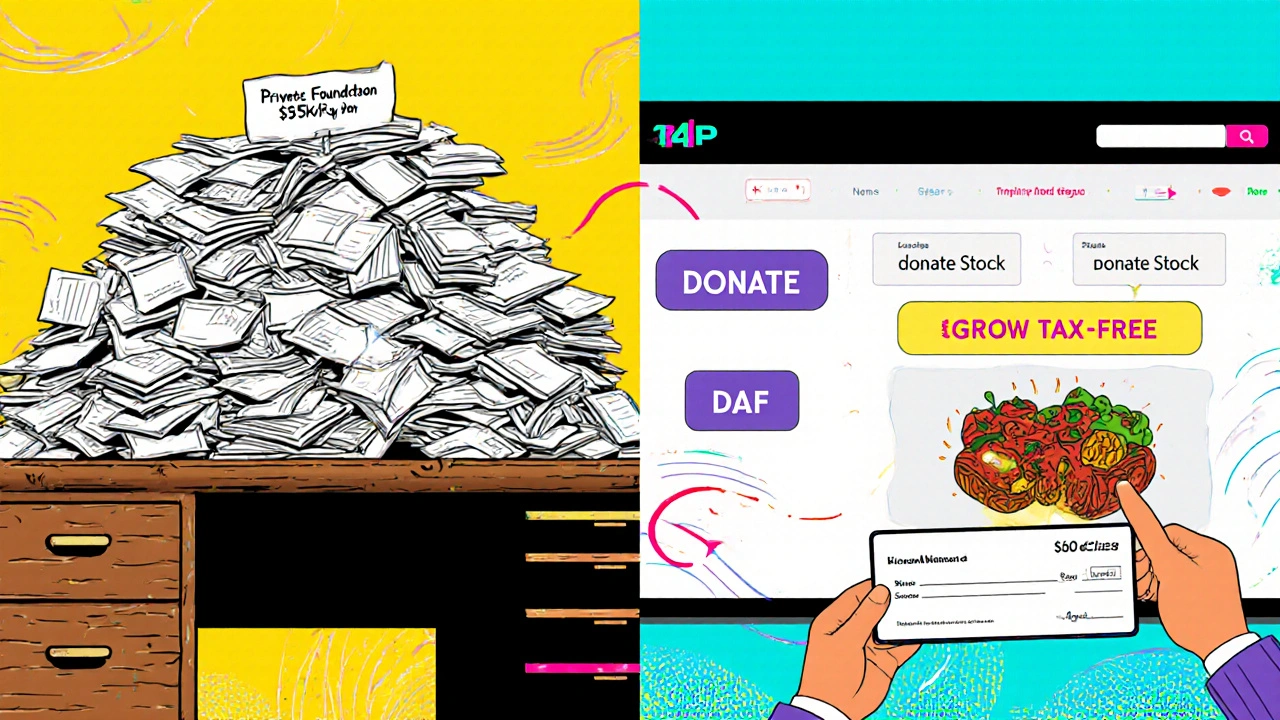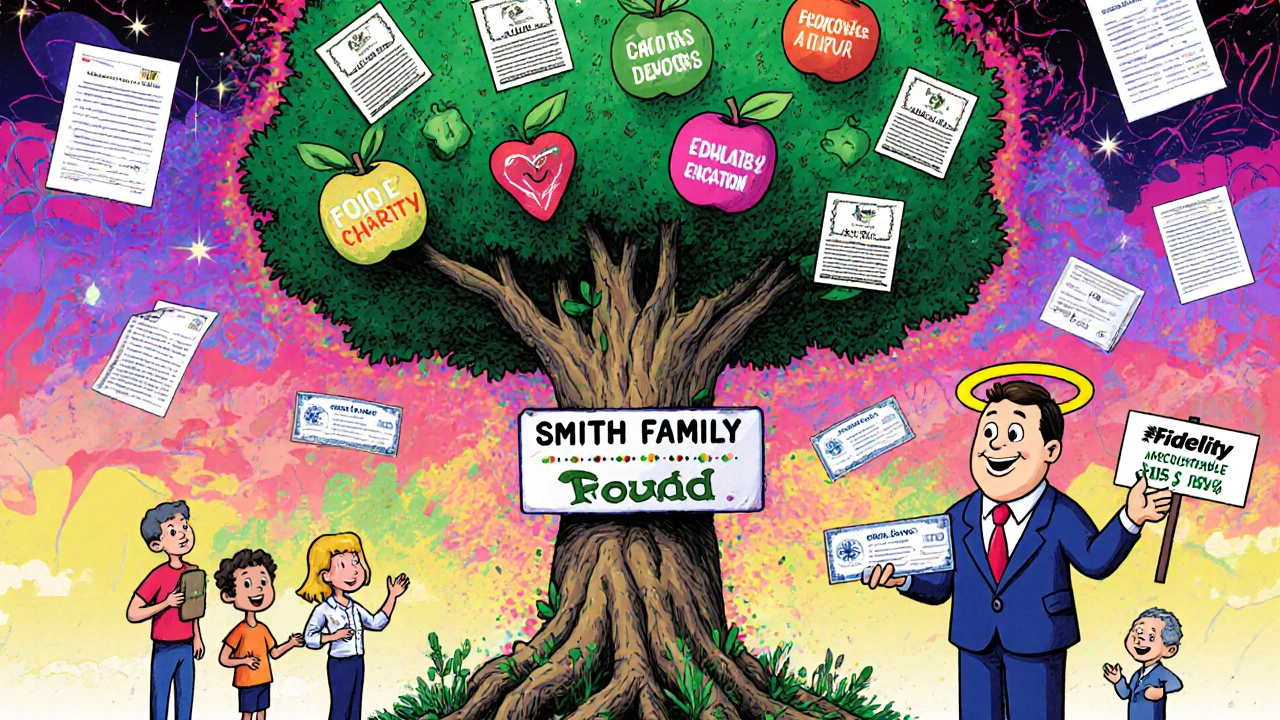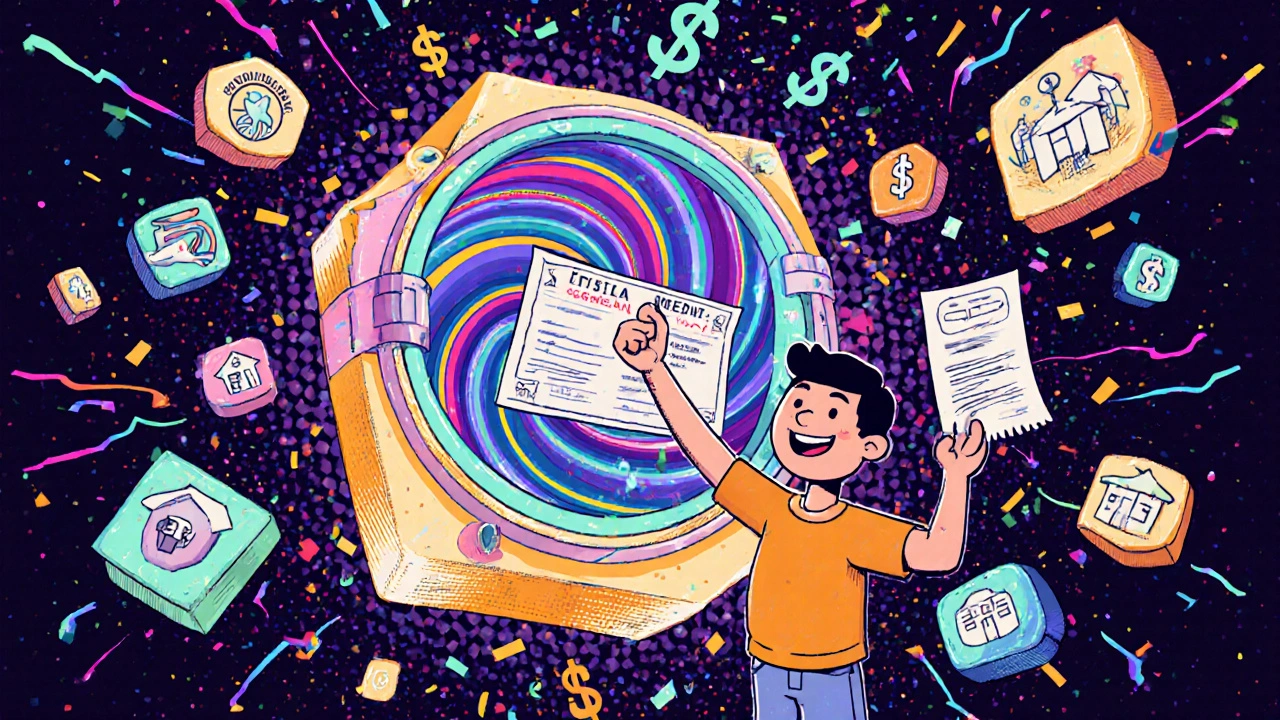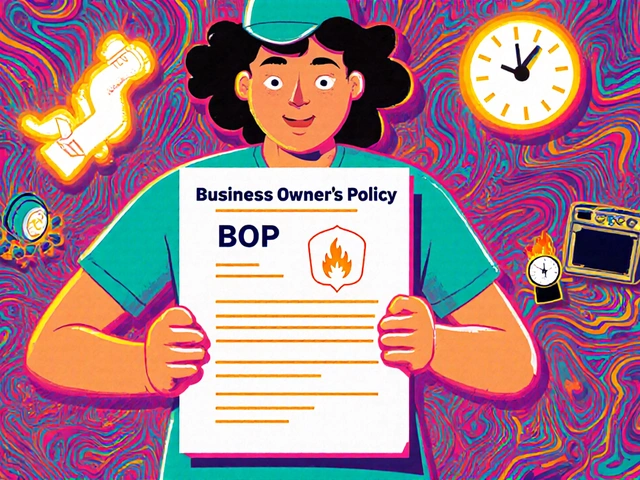DAF Capital Gains Tax Savings Calculator
Save on Capital Gains Tax
Calculate your tax savings when donating appreciated assets to a donor-advised fund instead of selling them directly.
Results
Important: You can deduct up to 30% of your adjusted gross income for asset donations. Always consult a tax advisor for personalized advice.
What if you could give money to charity, get an instant tax break, and let your donation grow over time - all without running a nonprofit? That’s the real power of a donor-advised fund (DAF). It’s not a bank account. It’s not a private foundation. It’s something in between: a charitable investment account that lets you donate, invest, and give away money on your own timeline.
Since 2015, DAFs have grown from $45 billion in assets to over $207 billion in 2023. That’s a 20.7% annual growth rate. In 2023 alone, donors gave $47.8 billion from DAFs to charities across the U.S. That’s 35.8% of all charitable giving through DAFs that year. And it’s not just for the ultra-rich. The average DAF account holds $125,000. Most people who use them have between $25,000 and $500,000 to give. You don’t need millions to start one.
How a Donor-Advised Fund Works
A DAF is set up through a public charity - called a sponsoring organization. These include big names like Fidelity Charitable, Schwab Charitable, Vanguard Charitable, and local community foundations like The Boston Foundation. You open an account, contribute money or assets, and get an immediate tax deduction. Then you can recommend grants to any IRS-qualified 501(c)(3) nonprofit over time.
Here’s how it breaks down:
- You donate cash, stocks, real estate, or even artwork to your DAF.
- You claim a tax deduction in the year you make the donation - even if you don’t give the money to a charity right away.
- The sponsoring organization invests your contribution. It can grow tax-free.
- When you’re ready, you recommend a grant to a charity. The sponsor handles the paperwork and sends the money.
That’s it. No board meetings. No annual filings. No legal fees. You’re still in control of where the money goes - but the charity handles the compliance.
Why People Love DAFs (Especially with Stocks)
The biggest advantage? Avoiding capital gains taxes.
Let’s say you bought Tesla stock for $10,000 ten years ago. Today it’s worth $60,000. If you sold it yourself, you’d owe capital gains tax - maybe $12,000 or more. But if you donate the stock directly to a DAF, you avoid that tax entirely. You get a deduction for the full $60,000 market value. And the charity gets the full amount.
This works with any appreciated asset held over a year: mutual funds, real estate, private company stock, even cryptocurrency. The IRS lets you deduct the fair market value, not what you paid. That’s why financial advisors say DAFs are the smartest way to give away stocks.
According to Fidelity Charitable’s 2023 survey, 92% of users rated the grant recommendation process as “excellent.” Most grants under $5,000 are processed in 24-48 hours. Larger grants take 3-5 business days. You can give as little as $50 at a time.
Costs and Minimums
There’s no free lunch. DAFs charge fees - but they’re low compared to running a private foundation.
- Minimum to open: Fidelity Charitable: $5,000. Schwab Charitable: $5,000. Vanguard Charitable: $5,000. The Boston Foundation: $25,000.
- Annual fees: Fidelity: 0.6% on balances under $500,000. Schwab: 0.8-1.2%. Vanguard: 0.6%. Community foundations: 1-1.5%.
That means if you have $100,000 in your DAF, you’ll pay about $600 a year to Fidelity. For comparison, a private foundation costs $5,000-$15,000 a year just in accounting and legal fees. And you’d have to give away 5% of your assets every year - no exceptions.
DAFs have no mandatory payout. You can let money sit and grow for years. But here’s the kicker: the average payout rate in 2023 was 20.2%. Most people give out way more than the 5% private foundations are forced to give.

Who Runs These Funds?
Three big players control most of the market:
| Provider | Market Share | Assets Under Management | Annual Fee (up to $500K) |
|---|---|---|---|
| Fidelity Charitable | 31% | $53.2 billion | 0.6% |
| Schwab Charitable | 19% | $32.8 billion | 0.8-1.2% |
| Vanguard Charitable | 12% | $20.7 billion | 0.6% |
| Community Foundations | 25% | $51.7 billion | 1-1.5% |
Fidelity leads by a wide margin. It processed nearly 2.7 million grants in 2024 to over 213,000 different nonprofits. Schwab and Vanguard are close behind. Community foundations offer local expertise - great if you want to support schools, food banks, or arts groups in your area. But they charge more.
What You Can’t Do With a DAF
DAFs are powerful - but they’re not perfect.
- No naming rights forever. You can name your fund “The Smith Family Fund,” but you can’t create a permanent endowment like a private foundation.
- No board control. You can’t appoint yourself as president or hire staff. The sponsoring charity owns the account.
- Grant restrictions. You can’t give to non-501(c)(3) organizations. That includes foreign charities unless they have U.S. equivalency certification. One donor on Bogleheads lost a $25,000 grant because the international NGO didn’t meet the paperwork rules.
- No personal benefit. You can’t get tickets to a charity gala, buy merchandise, or receive services in return. The IRS cracks down hard on this.
- Processing delays. Even with fast platforms, grants can take days. If you need to help a charity right now, a DAF might not be fast enough.
Also, the IRS is watching. In 2022, they did 47 audits of DAFs - up from 12 in 2019. Most focused on donors who tried to get personal benefits from their gifts. Don’t test this.

Tax Rules You Need to Know
Getting the deduction right matters.
- Cash donations: You can deduct up to 60% of your adjusted gross income (AGI) in a single year.
- Appreciated assets (stocks, real estate): You can deduct up to 30% of your AGI.
- Excess donations: If you give more than those limits, you can carry forward the deduction for up to five years.
- Documentation: For non-cash gifts over $500, you must file IRS Form 8283. For anything over $5,000 (like art or private stock), you need a qualified appraisal.
A 2022 NPTrust survey found that 42% of new DAF donors were confused by these limits. Talk to a tax advisor before you donate. Mistakes here can cost you.
What’s New in 2024
DAFs are evolving.
In May 2024, Fidelity launched “Impact Pools” - pre-built investment portfolios tied to causes like climate change, education, or racial equity. You can choose to grow your DAF while supporting specific social goals. No extra fees. Just select your cause, and your money is invested accordingly.
Meanwhile, the Council on Foundations released a new set of “Best Practices” to standardize how DAFs report and communicate. They’re pushing for more transparency - especially around how long money sits in accounts before being given out.
And there’s political pressure. Senator Angus King introduced the “DAF Accountability Act” in February 2024. It would require a 5% annual payout - like private foundations - and stricter reporting. If it passes, DAFs could lose one of their biggest advantages: flexibility.
Still, analysts at Morningstar predict DAFs will grow to 15-18% of all U.S. charitable giving by 2027. That’s up from 11% in 2023. They’re becoming the default choice for smart donors.
Is a DAF Right for You?
Ask yourself these questions:
- Do you own appreciated assets (stocks, real estate) you want to donate?
- Do you want to give more than you can afford right now - and stretch your giving over years?
- Do you want to avoid capital gains taxes and maximize your deduction?
- Are you okay with letting a big organization handle the paperwork?
If you answered yes to most of these, a DAF is probably the best tool you’ve got.
If you want to run your own charity, hire staff, or give to international groups without certification - skip it. Go with a private foundation instead. But that costs $1-5 million to start and takes hours of admin work every year.
For 95% of people who care about giving wisely, a DAF is simpler, cheaper, and more powerful than anything else.
Start with $5,000. Donate a stock you’ve held for over a year. Let it grow. Recommend a grant to your favorite food bank or animal shelter next year. Then do it again. You’re not just giving money. You’re building a legacy - without the bureaucracy.






Comments
It's fascinating how DAFs subtly shift the moral architecture of philanthropy - from immediate, embodied giving to a kind of financial meditation on legacy. We're no longer just donating; we're optimizing benevolence through tax-efficient compounding. There's something almost poetic about holding space for future generosity, letting money grow like seeds in winter, waiting for spring. And yet, I wonder: does this mechanization of compassion dilute the human connection? When we detach the act of giving from its immediacy, do we risk turning empathy into an asset class? I’ve seen friends fund DAFs with appreciated stock, then wait three years to disburse - all while families in their own neighborhoods go hungry. The math is brilliant. The soul? Less clear.
DAFs are the ultimate tax-optimized philanthropic arbitrage play. You dump appreciated equities into the fund, capture the FMV deduction at 30% of AGI, let it sit in a low-fee, diversified portfolio (Fidelity’s 0.6% is basically free), and then cherry-pick grants over time like a hedge fund manager allocating capital. It’s not charity - it’s strategic wealth retention with a virtue signaling overlay. And the 20.2% payout rate? That’s not generosity - that’s behavioral nudging by the sponsoring orgs. They know you’ll eventually give, so they don’t push. Smart. But also kinda manipulative.
Oh wow, another ‘DAFs are magical’ love letter from the financial influencer industrial complex. Let me guess - you’re the guy who donates Tesla stock to a DAF so you can write off $60k, then spends the next 5 years debating whether to fund the local food bank or that obscure Zimbabwean art collective. Newsflash: if you need a 24-hour grant turnaround, you’re not a philanthropist - you’re a tax cheat with a conscience complex. And ‘Impact Pools’? That’s just ESG with a nicer logo. The IRS audits are rising because people are trying to get free concert tickets through their DAF. You’re not building a legacy - you’re gaming the system with a spreadsheet.
Interesting read. 😊 I live in India and we don’t have DAFs here, but I think the idea is beautiful. Maybe one day we’ll have something like this - with lower fees and local focus. For now, I just give directly to small NGOs. Simple. No paperwork. Just heart. 🙏
Thank you for this clear breakdown. I’ve been considering a DAF but was overwhelmed by the rules around appreciated assets and Form 8283. Your explanation of the 30% AGI limit for stocks was the first time I truly understood it. I appreciate how you highlighted the trade-offs - especially the lack of control over grant timing. I’m not in a rush to give, but I don’t want to be the person who hoards $500k in a DAF for 15 years. Maybe I’ll start with $10k in appreciated shares and set up auto-grants to my local library and animal shelter. Small, steady, intentional. That feels right.